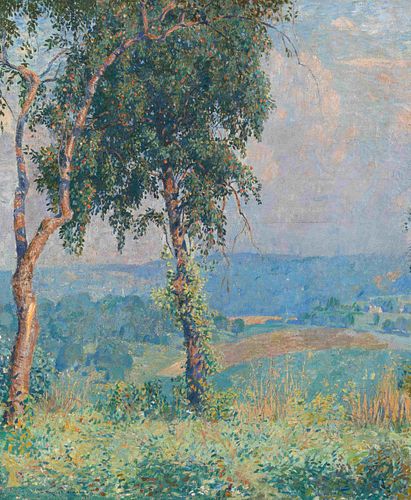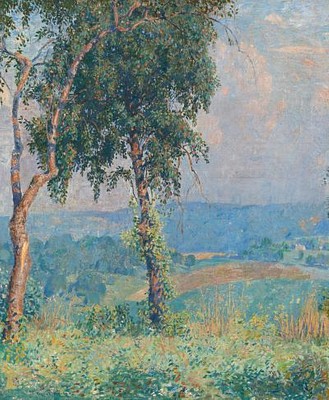Daniel Garber(American, 1880-1958)Near Solebury, 1917 (repainted 1918)
Lot 50
About Seller
Hindman
1338 West Lake Street
Chicago, IL 60607
United States
Recognized as the Midwest's leading fine art auctioneers, Hindman Auctioneers has built a worldwide reputation based on a full service approach to the auction business tailored to meet the individual needs of our clients. Coming from a variety of educational backgrounds, specialists bring years of e...Read more
Estimate:
$70,000 - $90,000
Absentee vs Live bid
Two ways to bid:
- Leave a max absentee bid and the platform will bid on your behalf up to your maximum bid during the live auction.
- Bid live during the auction and your bids will be submitted real-time to the auctioneer.
Bid Increments
| Price | Bid Increment |
|---|---|
| $0 | $25 |
| $500 | $50 |
| $1,000 | $100 |
| $2,000 | $250 |
| $5,000 | $500 |
| $10,000 | $1,000 |
| $20,000 | $2,500 |
| $50,000 | $5,000 |
| $100,000 | $10,000 |
About Auction
By Hindman
May 3, 2021
Set Reminder
2021-05-03 11:00:00
2021-05-03 11:00:00
America/New_York
Bidsquare
Bidsquare : American & European Art
https://www.bidsquare.com/auctions/hindman-auctions/american-european-art-6794
Hindman Bidsquare@hindmanauctions.com
Hindman Bidsquare@hindmanauctions.com
- Lot Description
Daniel Garber
(American, 1880-1958)
Near Solebury, 1917 (repainted 1918)
oil on canvas
signed Daniel Garber (lower left)
30 ¼ x 25 ¼ inches.
Accompanied by a photograph of the painting, which bears on the verso an inscription by the artist.
Provenance:
The artist
Private Collection, Chicago, purchased directly from the above
By descent through the family to the present owner
Exhibited:
Philadelphia Art Alliance, November 13 - 16, 1918, no. 33
New York, Folsom Galleries, Exhibition of Paintings by Daniel Garber, March 10 - 31, 1919, no. 10
Literature:
Artist's Record Book I, p. 19; II, p. 107
Yarnall Abbott, "An Appreciation of Daniel Garber, Landscape Artist: Great Painter Exhibits Canvases at the Art Alliance All This Week," Philadelphia Press, November 17, 1918
"Daniel Garber at Folsom's," American Art News, no. 23, March 15, 1919, p. 3
Frederick James Trigg, "Daniel Garber Shows New Freedom in Work," Herald (New York), March 23, 1919
Lance Humphries, Daniel Garber: Catalogue Raisonne, vol. II, New York, 2006, no. P374, p. 133, illus.
Property from the Estate of Avis Hope Truska, Scottsdale, Arizona
Lot essay:
A master of sparkling sunlight, Daniel Garber is widely thought of as one of the most influential Pennsylvania Impressionists. He studied in Europe for two years before returning to the United States in 1907, where he settled in Bucks County with his wife, Mary Franklin Garber. The bucolic landscape had enchanted the artist earlier, when he was introduced to the area by William Lathrop, then the leader of the New Hope School. Garber and his wife purchased a farmhouse in Cuttalossa Glen, a hamlet in the Delaware River Valley which offered inspirational scenic views. As Metropolitan Museum of Art Curator Sylvia Yount explains, "It was from his home base at Cuttalossa that Garber built his life - his career as a teacher, his reputation as a painter, and of course his work: vistas of quarries and forests along the Delaware; calm, transcendental domestic scenes with his family as subjects." Garber transformed the property to reflect the ideal, picturesque world he envisioned, grooming both the land and the buildings on it.
Garber preferred to paint the Buck County views in the spring and summer, in order to better capture the verdant landscape at its most luxuriant. Near Solebury is no exception. Characteristic of Garber’s work in the 1910s, the landscape is divided into three distinct layers. The foreground is dotted with variegated leaves and grasses, while the mid-ground focuses on the lush, rolling hills, depicted in jeweled tones of green and blue. The sky fills nearly the entire upper half of the composition, awash in pastel pinks, blues, and whites. Two trees divide the layers and provide a visual contrapuntal to the horizontals of the landscape, a technique frequently used by the artist. The brushstrokes that define the foreground elements are distinct and contrast against the hazy, dream-like valley and sky. Garber’s expert handling of colors suggests the subtle effects of light and shadow and gives the impression the sun is shimmering through lacy leaves and grasses.
A charcoal drawing (Private Collection, Pennsylvania) related to the present artwork shows a woman walking under the trees. Since Garber recorded that he repainted Near Solebury in 1918, it is possible that the canvas originally contained the figure as well. By leaving the landscape uninhabited, the artist deepens the tranquility of the scene and allows it to act as a warm memory of an idyllic day.For condition inquiries please contact marygracebilby@hindmanauctions.comCondition
- Shipping Info
-
Please refer to https://hindmanauctions.com/shipping-packing
-
- Buyer's Premium



 EUR
EUR CAD
CAD AUD
AUD GBP
GBP MXN
MXN HKD
HKD CNY
CNY MYR
MYR SEK
SEK SGD
SGD CHF
CHF THB
THB





















